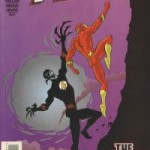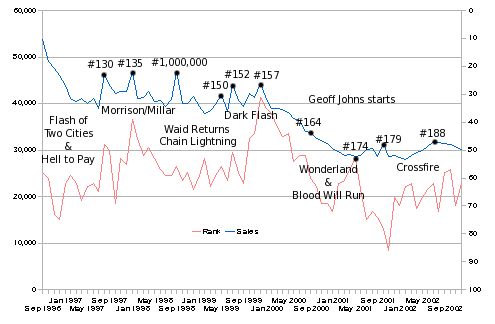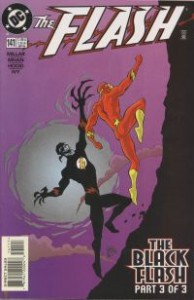In responding to Comic Treadmill’s review of Final Crisis #1, I realized that a common thread links many of the criticisms various people have leveled at the series: a change in balance between plot, continuity, and theme. I’ll try to keep this as spoiler-free as I can.
Plot-Driven Events
We’ve gotten used to event books where the most important elements are plot and continuity, almost to extreme. Books like The OMAC Project, Day of Vengeance and Rann-Thanagar War were accused of being bullet-point series, where the writers seemed to be going down a checklist of items that had to happen. Villains United differed by emphasizing characterization, and proved to be the stand-out among the four Infinite Crisis lead-ins.
Looking back at Infinite Crisis: what was the theme? Early on there seemed to be a concept of “Okay, the world’s fundamentally broken. Do you fix it or start over?” — but that went by the wayside as it turned into villain threatens the universe and heroes must stop him. If anything, perhaps the value of perseverance?
Focus on Theme
With Final Crisis, people have complained about the “filler” — the caveman battle in issue #1, the Japanese super-hero team at the night club in issue #2, etc. — and about continuity. Either there’s too much continuity, because it uses obscure characters, or there’s not enough, because it conflicts with Countdown and Death of the New Gods (which didn’t quite line up themselves).
I think what Grant Morrison is doing is writing a story where theme is more important than plot. What happens, or how it happens, isn’t as important as why it happens. And so far, the “why” is all about humanity’s capacity for corruption. From taking the prehistoric gift of fire and turning it into a weapon of war, to taking the modern-day gifts of super-powers and turning them into a tool for popularity, we see how humans can misuse their potential. Similarly, there’s the detail of the community center becoming a strip club. The corrupting influence of Darkseid and his minions fits right in.
Balance
There’s also the “Evil won” concept, where Libra mentions that the balance has shifted between good and evil. Morrison has previously treated the fact that the good guys (almost) always win as part of the nature of the DCU. In JLA #9, the Key took advantage of this to set up a scenario such that the Justice League winning would further his own plans. More prominently, in JLA: Earth 2, the League tried to travel to the Crime Syndicate’s world and correct as many injustices as they could in a limited time period. Because the nature of that universe was opposite — there, evil always won — none of the League’s victories could last. Kurt Busiek later picked up on this for his “Syndicate Rules” arc. The key setup for Final Crisis seems to be that the rules have changed, and until they’re changed back, evil will always have the upper hand. This explains why, as one reviewer put it, heroes are getting taken out like teenagers in a slasher movie.
Clearly, for the story to not be totally depressing and destroy the DCU, part of the story will have to be about redressing that balance.
For the record: I’m not a giant Grant Morrison fan. I enjoyed his run on JLA, DC One Million, his Flash run, and Seven Soldiers. I’ve read the first trade (or perhaps two) of The Invisibles and maybe two issues of Animal Man, and none of Doom Patrol. Seaguy left me utterly confused, but I think I need to re-read it now. I don’t think I’ve read any of his Marvel work, or Image, or anything he did before breaking into the US market.
 Rumor column Lying in the Gutters seems to think that the upcoming Emergency Stop trade paperback contains the entire Morrison/Millar run on The Flash from 1997. And considering that Amazon is currently quoting a list price of $60(!), I certainly hope so! For that price — heck, even for the discounted price of $37.80 — it ought to be both complete and a hardcover!
Rumor column Lying in the Gutters seems to think that the upcoming Emergency Stop trade paperback contains the entire Morrison/Millar run on The Flash from 1997. And considering that Amazon is currently quoting a list price of $60(!), I certainly hope so! For that price — heck, even for the discounted price of $37.80 — it ought to be both complete and a hardcover!

 Here’s a quick update on the earlier post about the
Here’s a quick update on the earlier post about the